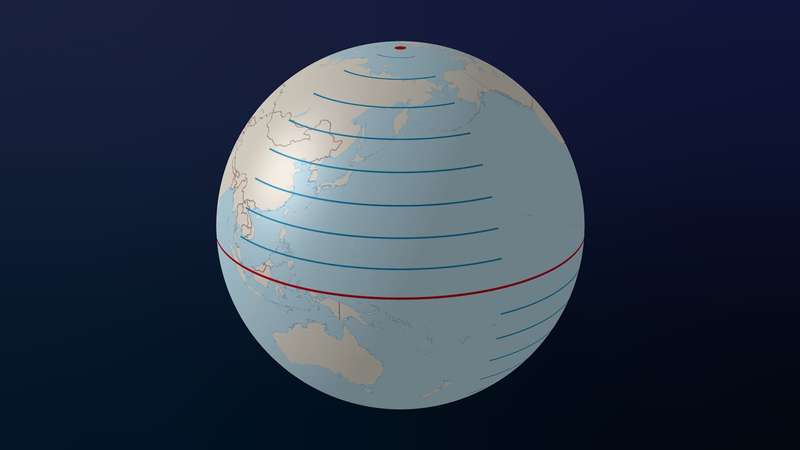
Portions of latitude circles on the Earth. As you move southward the size of the latitude circles changes more rapidly near the poles than it does near the equator. (image credit: Encyclopedia Brittanica)
Why does the period of precession depend on latitude? Think about the circles that points on Earth's surface move along as Earth rotates. How does the size of these circles change as you move north or south? The radius of the circle is just the distance of the point on Earth's surface from the rotational axis that passes through Earth's center. Near the North Pole, as the pendulum moves southward, it is moving almost directly away from the rotational axis. As a result, the size of the circles changes relatively rapidly as the pendulum swings. This rapid change in size results in a larger curve in the pendulum's motion and thus a faster rate of precession (and shorter precession period). In contrast, near the equator the pendulum's north-south motion is almost entirely parallel to the rotational axis. Thus, the size of the circles changes relatively slowly and the pendulum will curve very little, giving it a slow precession rate (and a long precession period).

Physicists think of the pendulum's precession as resulting from the so-called "Coriolis force." The Coriolis force is not a real force, but rather an effect on the motion of objects when observed in a rotating reference frame (like that of an observer standing on a rotating Earth). The eastward deflection of a falling object, discussed on a previous page, can also be attributed to the Coriolis force.
The Coriolis force is similar to the so-called centrifugal force that seems to push the driver of a car against the driver's door when the car is turning to the right. Like the Coriolis force, the centrifugal force is not a real force but is instead an effect of being in a reference frame that is changing its direction of motion.
Because the Coriolis force on the swinging pendulum is generally stronger near the poles than it is near the equator, the pendulum experiences a larger deflection per swing near the poles. This larger deflection results in a faster precession and a shorter precession period. On the equator the Coriolis force vanishes and there is no precession (so the precession period is infinite). In the southern hemisphere the Coriolis force points in the opposite direction, which reverses the direction of precession.